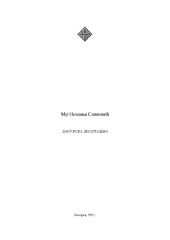| dc.contributor.advisor | Радуловић, др Ксенија | |
| dc.contributor.advisor | | |
| dc.contributor.advisor | 2021-06-11 | |
| dc.contributor.other | Мркић Поповић, др Љиљана | |
| dc.contributor.other | Ромчевић, др Небојша | |
| dc.contributor.other | Миливојевић Мађарев, др Марина | |
| dc.creator | Савковић, Немања | |
| dc.date.accessioned | 2021-04-09T09:01:38Z | |
| dc.date.available | 2021-04-09T09:01:38Z | |
| dc.date.issued | 2021-06-11 | |
| dc.date.submitted | 2021-04-09 | |
| dc.identifier.uri | http://eteze.arts.bg.ac.rs/handle/123456789/508 | |
| dc.description.abstract | У овом раду покушали смо да истражимо и критички просудимо теоријску мисао о глуми у српском културном простору од њеног настанка с краја четврте деценије 19. века до 1944. године. За тих стотинак година знатан број аутора окушао се у теоријском сагледавању глуме. Међу њима било је позоришних критичара, драмских писаца, естетичара, позоришних руководилаца, редитеља, историчара позоришта, глумаца и професора филозофије, а њихове мисли о глуми налазимо у чланцима из дневних и периодичних публикација и књигама (студијама, расправама, уџбеницима). Разликујемо четири раздобља повести промишљања глуме у наведеном временском опсегу. Прво раздобље траје од краја тридесетих до почетка седамдесетих година 19. века, тј. од појаве новосадског Летећег дилетантског друштва и рађања домаће позоришне публицистике до оснивања првих професионалних позоришта (Српског народног позоришта у Новом Саду и Народног позоришта у Београду) и покретања првог позоришног часописа (новосадско Позориште). Друго раздобље траје до средине деведесетих година 19. века, колико траје и оснивачка фаза у раду ових двају позоришта и колико траје доминација старог ‒ „догматичког“ ‒ стила наше позоришне критике, заснованог углавном на принципима немачке естетике и теорије позоришта. Треће раздобље окончава се избијањем Првог светског рата; главне су му карактеристике почетак процеса модернизације српског позоришта и преваленција импресионистичког стила и француског духа у позоришној критици, при чему водећу улогу у ширењу мисли о позоришту преузима београдски Српски књижевни гласник. Четврто раздобље траје од свршетка Првог светског рата до ослобођења Београда у Другом светском рату и гашења позоришног часописа Српска сцена, а обележено је, испрва, настојањима да се позоришни живот и позоришно мишљење обнове, размахну и осавремене у измењеном друштвено-политичком и културном контексту (стварање нове државне заједнице, долазак руске позоришне емиграције, експанзија модерне књижевности и филма, идеологизација уметности), а потом и настојањима да позориште и мисао о позоришту опстану у условима поновне окупације и немачке културне колонијализације. | en |
| dc.description.abstract | In this paper we have tried to research and critically judge the theoretical thought about acting in the Serbian cultural space since its inception in the end of the fourth decade of the 19th century until 1944. During those hundred years, a significant number of authors tried their hand at theoretical understanding of acting. Among them were theater critics, playwrights, aesthetics, theater directors, directors, theater historians, actors and professors of philosophy, and their thoughts on acting can be found in articles from daily and periodical publications, as well as in the books (studies, discussions, textbooks). We can distinguish four periods in the history of the reflection about acting in the stated time range. The first period lasts from the late thirties to the early seventies of the 19th century, ie. since the debut of the Flying Amateur Society from Novi Sad and the beginning of domestic theater journalism until the foundation of the first professional theaters (Serbian National Theater in Novi Sad and the National Theater in Belgrade) and the launch of the first theater magazine (Theater from Novi Sad). The second period lasted until the mid-1890s, as long as the founding phase of the work in these two theaters and the domination of the old - „dogmatic“ - style of our theater criticism, based mainly on the principles of German aesthetics and theater theory. The third period ended with the outbreak of the First World War; its main characteristics are the beginning of the process of modernization of Serbian theater and the prevalence of impressionist style and French spirit in theater criticism, whereby the leading role in spreading the idea of theater is taken over by the Serbian Literary Gazette from Belgrade. The fourth period lasts from the end of the First World War until the liberation of Belgrade in the Second World War and the closure of the theater magazine Serbian Stage. At first, it was characterized by efforts to renew, expand and modernize theatrical life and theatrical thinking in a changed socio-political and cultural context (creation of a new state union, the arrival of Russian theatrical emigration, expansion of modern literature and film, ideologization of art), and also by the attempts to keep the theater and the idea of theater in the conditions of re-occupation and German cultural colonialization. | en |
| dc.language.iso | sc | en |
| dc.publisher | Универзитет уметности у Београду, Факултет драмских уметности | sr |
| dc.source | Факултет драмских уметности | sr |
| dc.subject | acting, actor, acting style, acting creation, acting theory | en |
| dc.subject | глума, глумац, глумачки стил, глумачко стваралаштво, теорија глуме | en |
| dc.title | Теоријска мисао о глуми у српском културном простору до 1944. године | en |
| dc.type | doctoralThesis | en |
| dcterms.abstract | Radulović, dr Ksenija; Romčević, dr Nebojša; Milivojević Mađarev, dr Marina; Mrkić Popović, dr Ljiljana; Savković, Nemanja; Teorijska misao o glumi u srpskom kulturnom prostoru do 1944. godine; | |
| dc.contributor.coadvisor | Рапајић, Светозар | |


